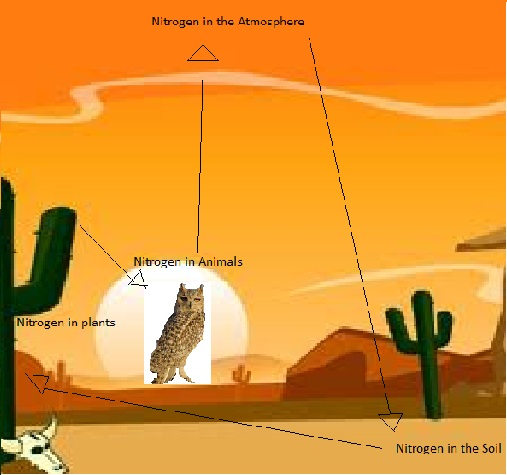Nitrogen Cycle Basics
- Nitrogen gas may be removed from the atmosphere by bacteria through a process of Nitrogen Fixing; the opposite where bacteria returns Nitrogen to the atmospheres called dentrification (a form of anaerobic respiration).
- Assimilation: the uptake of ammonium ion and nitrate ion from soil by plants and the uptake of organic nitrogen by animals and plants

How Nitrogen Flows through a Desert
A basic example of the nitrogen cycle in a desert biome begins with the uptake of nitrates by desert plants. The plants that contain the nitrate are then consumed by insects and and reptiles. These primary consumers are then eaten by secondary consumers, transferring the nitrates from the primary consumers to the secondary consumers. The nitrogen-bearing compounds in these animals are passed further up the food chain to larger carnivores such as coyotes and birds of prey. These carnivores are at the top of their food chains and when they die the nitrogen is returned to the soil. Finally back to soil, bacteria and fungi mineralize the nitrogen back to a usable state for plants. Bringing the cycle back to the beginning.
What is the importance of the Nitrogen Cycle to the Desert Biome?
Knowing that once the bacteria converts the nitrogen into a usable material for plants, the material goes to help with plant growth. If the bacteria in the soil was unable to process the nitrogen, the plants will be unable to grow properly, if at all. If the plants cannot grow, then the plants will die out. If the plants die out, then the primary consumers will have to find a new source of food or die of starvation. The lack of primary consumers takes away the valuable food source for the secondary consumers. This leaves the top predators without food as well.
Just by disrupting the nitrogen cycle in a single place, it disrupts the entire food chain. This disruption leaves the ecosystem bare and uninhabitable. The nitrogen Cycle provides stability and order to the ecosystem.
How does the way that matter flows throughout an ecosystem differ from the way that energy flows through an ecosystem?
-
Energy doesn't cycle through ecosystems, rather they enter ecosystems and are used up within ecosystems.
-
Chemical elements such as carbon and nitrogen are produced by and cycled between abiotic and biotic components of an ecosystem.
-
Energy is lost in most ecosystems in the form of waste heat. Where as nitrogen is recycled and used in the cycle continuously.
-
Because energy cannot be recycled, an ecosystem must be provided with a continuous stream of energy from an outside source (the sun)
-
Energy generally passes as bonds between carbon atoms and bonds between carbon and hydrogen atoms.